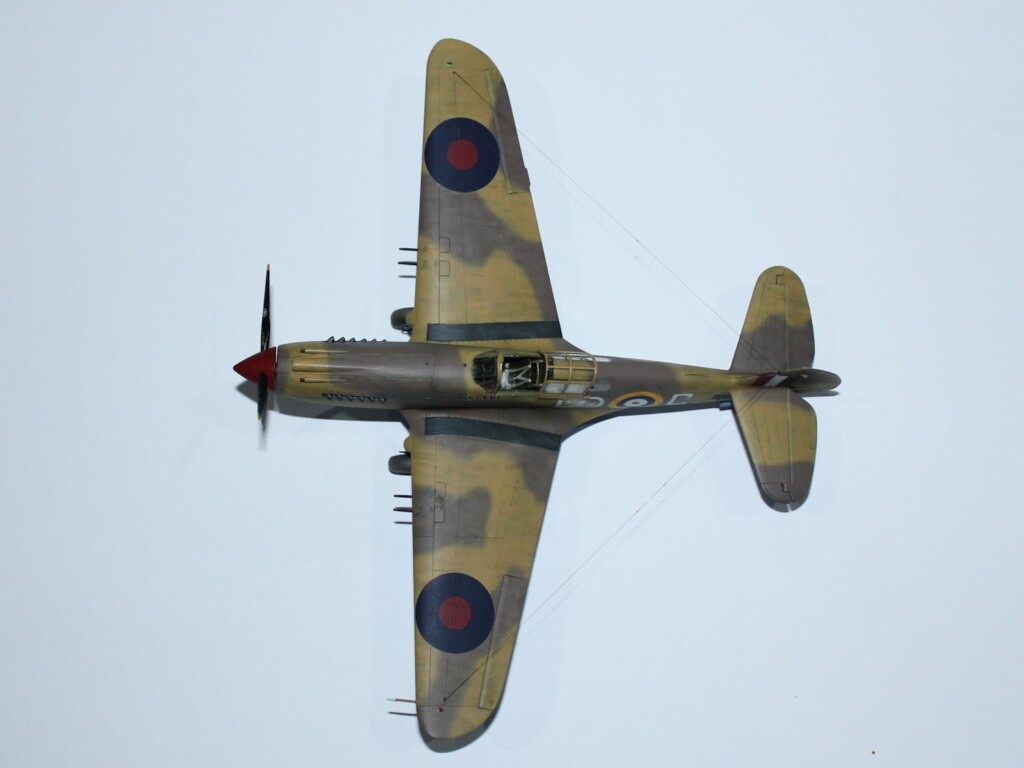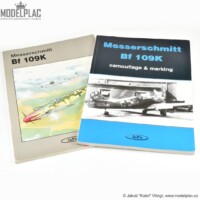Top P-40 Ace
This article is part of a series:
This the first of six P-40s I built earlier last year for a club display for the Australian Model Expo. I built them as one group of three and a second group of four. A seventh aircraft was not finished in time for Expo but is now completed.
-
Top P-40 Ace
Subject
With 28.5 victories, Clive Caldwell was the top scoring Australian pilot of World War 2. He flew this aircraft while with 250 Sqn RAF and destroyed two Bf 109s on the 23rd of November 1941 and then five Ju 87s on the 5th of December. He scored his ninth kill in this aircraft, another Bf 109, on the 20th of December to bring his total to 18.
Caldwell perfected his marksmanship using a method of his own creation, shadow shooting. On returning from a mission at low level he noticed his aircraft's shadow keeping pace and decided to practice his aim by shooting at it. This technique, alternatively using a wingman's shadow, was later adopted as a standard training technique by the Desert Air Force.
In January 1942, Caldwell was promoted to Squadron Leader and transferred to be the CO of 112 Sqn which had recently converted to Kittyhawk IAs and with whom he scored another three and one shared kills. This total of 21.5 kills made Clive the top P-40 Ace of the war and the highest scoring Allied pilot in North Africa.
Like many Australian pilots, Clive was recalled to Australia later in 1942 to take command of No. 1 Fighter Wing. Nicknamed the "Churchill Wing", it was composed of three squadrons, No. 452 Squadron RAAF, No. 457 Squadron RAAF and No. 54 Squadron RAF, transferred from the European theatre and flying the Spitfire Vc, as promised to the Australian Minister for External Affairs H.V. "Doc" Evatt by Churchill.
Caldwell went on to score a further seven victories over the Japanese, making him one of the rare pilots to have achieved Ace status in two theatres and to have shot down aircraft of each of the three major Axis powers, Germany, Italy and Japan.
After a stint commanding No 2 Operational Training Unit (2OTU) based at Mildura, Victoria, he was posted to command No. 80 Wing flying the Spitfire Mk VIII from Darwin in 1944. By April 1945, the wing was based at Morotai in the Dutch East Indies (present day Indonesia) flying mopping up missions while the war moved on to the Philippines.
Frustrated by what they saw as pointless missions that needlessly put their men at risk, Caldwell and other senior officers staged what became known as the “Morotai Mutiny” in protest to senior officers having let the RAAF be regulated by their US ally to the mopping up operations in the now backwaters of New Guinea, the Solomon Islands and Borneo rather than participate in the operations against the Philippines and Japan proper.
On the recommendation of the Chief of the Air Staff, Air Vice-Marshal Jones, the Minister for Air, Arther Drakeford, called for an inquiry into the issues affecting First TAF. A commission headed by John Barry KC, found that the complaints were justified and the officers who had resigned were exonerated and reinstated. The Air Officer Commanding First TAF, Air Commodore Coby, and two other senior staff were relieved of their appointments. These events demonstrated both the problems of working under MacArthur's command and the inherent weakness in the higher command of the RAAF.
This model represents the mount of then Flt. Lt. Clive Caldwell, when he was with 250 Sqn RAF flying from (Landing Ground) LG 123 Maddelena 3, Libya in 1941.
Construction
The cockpit was built more or less out of the box except for the addition of Eduard painted RAF seatbelts. A bit of research on "Curtiss Interior Green" led me to selecting Gunze H81 Khaki as a close match (to my eye, and without requiring mixing colours) with a few highlights in H80 Khaki Green.
One thing the kit lacks, when building a RAF machine, is the gunsight. US P-40B/Cs had a unique gunsight arrangement with the sight on the cockpit floor projecting onto a glass reflector at eye level. This arrangement was hampered by structural flexing, and probably vibration, when manoeuvring. The British, instead, had a conventional gunsight installed, mounted on a tubular framework, which the kit does not provide. I have an Eduard Spitfire Mk. I dual boxing, one of which I intend to build with a ring sand bead sight, so I stole the gunsight from that and used copper wire for the curved mounting struts.
Curiously, Arifix has recessed the underwing ammunition bins, so I filled these in and rescribed the outline.
Something I noticed late in the build is that the rudder trim tab is only scribed on the starboard side, something that is also the case on a second kit that I have. So, I scribed the port side.
Also, at this point I noticed sink mark on the lower port side of the rudder but decided to leave that as it would have been difficult to fix at this late stage of the build.
I added a ring and bead sight (well, two bead posts until I find a suitable ring sight) to the upper forward fuselage.
Painting and Markings
The aircraft is painted in the standard RAF desert camouflage pattern of Dark Earth (Gunze Sangyo H72 Dark Earth) and Mid Stone (SMS PL75 Mid Stone (FS 30266)) over Azure Blue (SMS PL74 Azrue Blue (FS 35231)) with a red spinner (Gunze H13 Flat Red).
These are Novascale decals. The white LD-C are doubled up for opacity and worked quite well but almost silvered until I used some decal softener. I also used the serial and score board, but the national insignia are Techmod because the red and yellow portions of the Novascale ones are clearly dot-matrix printed.
The radio wires for the Tomahawk run from fin to near the wing tips with a third wire leading into fuselage spine.
A bit of weathering and exhaust stains and it was done.















Perfect P-40 and an interesting story as well. Great job and thanks for sharing, Michael!
Nice work, Michael. That’s a really enjoyable kit.
Well built and weathered. Those blokes at war's end got a dirty ended stick all right.
Very nicely made P-40… great painting & weathering.
Very very nice! In the kill markings there is Italian sign?
Great work @michaelt and a superb result.
Excellent paint work and model.
Excellent post - great work on the model and interesting story.
Another fine looking P40, Michael @michaelt
Interesting article about Clive as well.
Truly a beautiful build. And it sounds like you did a fair amount of research.
Excellent job and fantastic result, Michael! Great writeup, too!
One can never have too many "hawks" in one's collection! Another great-looking bird - well done.
I never get tired of seeing you awesome P-40 builds Michael! I appreciate your background history as well, always great information. Keep it up.